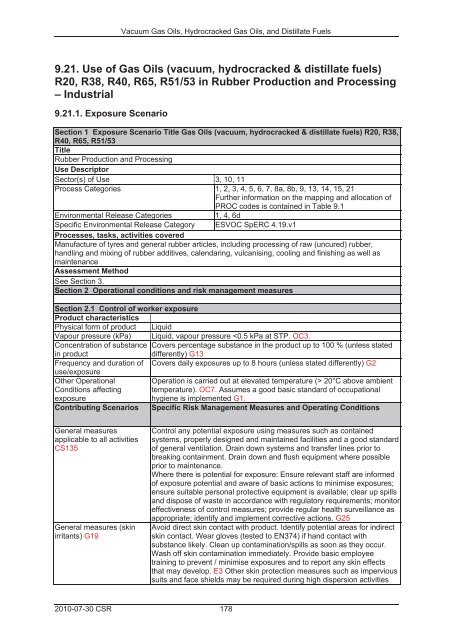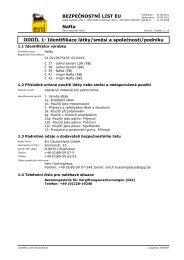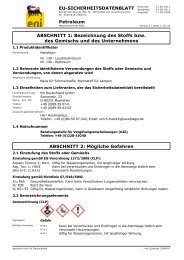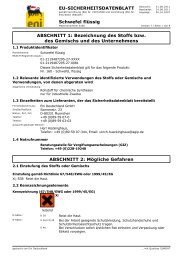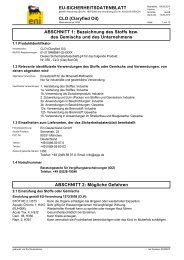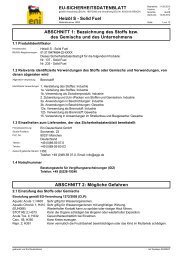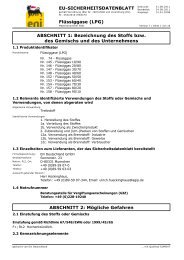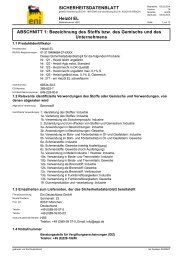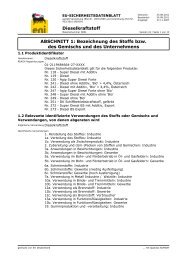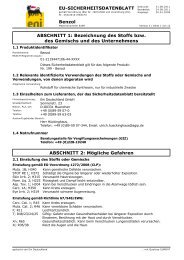EU-SICHERHEITSDATENBLATT Dieselkraftstoff ... - Schmierstoffe
EU-SICHERHEITSDATENBLATT Dieselkraftstoff ... - Schmierstoffe
EU-SICHERHEITSDATENBLATT Dieselkraftstoff ... - Schmierstoffe
Create successful ePaper yourself
Turn your PDF publications into a flip-book with our unique Google optimized e-Paper software.
Vacuum Gas Oils, Hydrocracked Gas Oils, and Distillate Fuels<br />
9.21. Use of Gas Oils (vacuum, hydrocracked & distillate fuels)<br />
R20, R38, R40, R65, R51/53 in Rubber Production and Processing<br />
– Industrial<br />
9.21.1. Exposure Scenario<br />
Section 1 Exposure Scenario Title Gas Oils (vacuum, hydrocracked & distillate fuels) R20, R38,<br />
R40, R65, R51/53<br />
Title<br />
Rubber Production and Processing<br />
Use Descriptor<br />
Sector(s) of Use 3, 10, 11<br />
Process Categories 1, 2, 3, 4, 5, 6, 7, 8a, 8b, 9, 13, 14, 15, 21<br />
Further information on the mapping and allocation of<br />
PROC codes is contained in Table 9.1<br />
Environmental Release Categories<br />
1, 4, 6d<br />
Specific Environmental Release Category ESVOC SpERC 4.19.v1<br />
Processes, tasks, activities covered<br />
Manufacture of tyres and general rubber articles, including processing of raw (uncured) rubber,<br />
handling and mixing of rubber additives, calendaring, vulcanising, cooling and finishing as well as<br />
maintenance<br />
Assessment Method<br />
See Section 3.<br />
Section 2 Operational conditions and risk management measures<br />
Section 2.1 Control of worker exposure<br />
Product characteristics<br />
Physical form of product Liquid<br />
Vapour pressure (kPa) Liquid, vapour pressure 20°C above ambient<br />
Conditions affecting temperature). OC7. Assumes a good basic standard of occupational<br />
exposure<br />
hygiene is implemented G1.<br />
Contributing Scenarios Specific Risk Management Measures and Operating Conditions<br />
General measures<br />
applicable to all activities<br />
CS135<br />
General measures (skin<br />
irritants) G19<br />
Control any potential exposure using measures such as contained<br />
systems, properly designed and maintained facilities and a good standard<br />
of general ventilation. Drain down systems and transfer lines prior to<br />
breaking containment. Drain down and flush equipment where possible<br />
prior to maintenance.<br />
Where there is potential for exposure: Ensure relevant staff are informed<br />
of exposure potential and aware of basic actions to minimise exposures;<br />
ensure suitable personal protective equipment is available; clear up spills<br />
and dispose of waste in accordance with regulatory requirements; monitor<br />
effectiveness of control measures; provide regular health surveillance as<br />
appropriate; identify and implement corrective actions. G25<br />
Avoid direct skin contact with product. Identify potential areas for indirect<br />
skin contact. Wear gloves (tested to EN374) if hand contact with<br />
substance likely. Clean up contamination/spills as soon as they occur.<br />
Wash off skin contamination immediately. Provide basic employee<br />
training to prevent / minimise exposures and to report any skin effects<br />
that may develop. E3 Other skin protection measures such as impervious<br />
suits and face shields may be required during high dispersion activities<br />
2010-07-30 CSR 178


